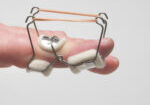Die 17 wichtigsten Fakten zur Weiterbildung in Physio- und Ergotherapie im Jahr 2025
abgelegt unter Nicht kategorisiert
1. Einführung in die Weiterbildung
Weiterbildung in Physio- und Ergotherapie ist mehr als nur eine Voraussetzung – sie ist der Schlüssel zum beruflichen Wachstum. In einem sich ständig weiterentwickelnden Bereich ist es nicht nur sinnvoll, auf dem Laufenden zu bleiben, sondern auch notwendig. Für Physiotherapeuten (PTs) und Ergotherapeuten (OTs) hilft Weiterbildung dabei, ihre Fähigkeiten zu verbessern, die Behandlungsergebnisse zu verbessern und die Zulassung zu erhalten.
Weiterbildung fördert:
- Aktualisiertes klinisches Wissen
- Höhere professionelle Glaubwürdigkeit
- Einhaltung der Lizenzierungsvorschriften

2. Was ist eine Weiterbildung in Physiotherapie?
Die Weiterbildung in Physiotherapie umfasst Lernaktivitäten, die das klinische Wissen und die Fähigkeiten erweitern. Diese können reichen von:
- Online-CEU-Module
- Workshops zur manuellen Therapie
- Erweiterte Zertifizierungen (z. B. Orthopädischer Facharzt)
PT CE stellt sicher, dass Therapeuten mit aktuellen Behandlungs- und Reha-Protokollen vertraut sind. Zu den Themen gehören häufig Schmerzbehandlung, Neurorehabilitation und postoperative Versorgung.
3. Was ist eine Ergotherapie-Weiterbildung?
Die Weiterbildung in der Ergotherapie konzentriert sich auf therapeutische Techniken, die die Aktivitäten des täglichen Lebens und die funktionelle Unabhängigkeit unterstützen. Zu den Weiterbildungsthemen für Ergotherapeuten gehören häufig:
- Sensorische Integration
- Handtherapie
- Unterstützung der psychischen Gesundheit
- Pädiatrische oder geriatrische Eingriffe
Es befähigt Therapeuten, evidenzbasierte Strategien anzuwenden, die auf die Bedürfnisse von Patienten aller Altersgruppen zugeschnitten sind.
4. Staatliche CE-Anforderungen für PTs und OTs
Jeder US-Bundesstaat legt seine eigenen Anforderungen für die Weiterbildung fest:
- Einige Staaten verlangen 20-30 Stunden alle 2 Jahre
- Andere erfordern möglicherweise spezifische Inhalte (z. B. Ethik oder Rechtswissenschaft).
- Die Nichterfüllung der Anforderungen kann die Lizenzerneuerung verzögern
Bleiben Sie über die Zulassungsbehörde Ihres Staates auf dem Laufenden, um Compliance-Probleme zu vermeiden.
5. CEU-Credits erklärt
A Weiterbildungseinheit (CEU) entspricht typischerweise 10 Kontaktstunden der Ausbildung. Der genaue Wert kann jedoch je nach Anbieter und staatlichen Vorschriften variieren. PTs und OTs benötigen in der Regel eine festgelegte Anzahl von CEUs für die Lizenzerneuerung – üblicherweise 1,5 bis 3 CEUs pro Zyklus.
Wichtiger Tipp: Überprüfen Sie immer, ob ein Kurs in Ihrem Bundesstaat als CEU zählt.
6. Akkreditierte CE-Anbieter, denen Sie vertrauen können
Es sollten nur Weiterbildungskurse von vertrauenswürdigen Anbietern besucht werden. Achten Sie auf:
- APTA (Amerikanische Vereinigung für Physiotherapie)
- AOTA (Amerikanische Vereinigung für Ergotherapie)
Die Akkreditierung dieser Organisationen ist in vielen Bundesländern nicht erforderlich, kann aber hilfreich sein, um die Zulassung in Ihrem Bundesland zu erhalten. Beide Organisationen empfehlen Anbieter und Plattformen, die strenge Bildungsstandards erfüllen.
7. Beliebte Themen in PT und OT CE im Jahr 2025
Zu den CE-Trendthemen dieses Jahres gehören:
- Neurologische Rehabilitation: Schlaganfall, TBI-Genesung
- Telemedizinische Praktiken: Fernpflegeprotokolle
- Altenpflege: Alternde Bevölkerung
- Pädiatrie: Sensorische Verarbeitung und Autismus
Diese Themen spiegeln die sich entwickelnden Bedürfnisse der Patienten und die wachsenden Therapienischen wider.
8. Online-Weiterbildungsplattformen
Online-CEU-Plattformen machen das Lernen flexibel und zugänglich. Plattformen wie Handtherapie-Akademie bieten mobilen Zugriff, interaktive Inhalte und Abschlusszertifikate.
9. Persönliche Workshops und Konferenzen
Die Teilnahme an Präsenzveranstaltungen bietet praktische Schulungen und Networking-Möglichkeiten. Zu den wichtigsten Konferenzen gehören:
- APTA-Konferenz der kombinierten Sektionen (CSM)
- AOTA-Jahreskonferenz
- Workshops der örtlichen Landesgremien
Bei diesen Veranstaltungen werden häufig CEUs angeboten und neue Modalitäten und Geräte vorgestellt.
10. Kosten und Budgetierung für CEUs
Die Kosten für CE variieren stark:
- Frei: Gesponserte Webinare oder Compliance-Module
- Niedrige Kosten: $50–$100 pro Kurs
- Prämie: Zertifizierungen oder Intensivkurse ($200+)
Einige Arbeitgeber erstatten die Kosten für Weiterbildung oder bieten interne Schulungen an. Fragen Sie daher bei Ihrer Personalabteilung nach.
11. So wählen Sie die richtigen CE-Kurse aus
Wählen Sie CE basierend auf:
- Ihr Spezialgebiet (z. B. Sportrehabilitation, Neuro-Ergotherapie)
- Fähigkeiten, die Sie entwickeln möchten
- Kursformat (live vs. im eigenen Tempo)
Richten Sie CE sowohl an den Lizenzierungs- als auch an den Karrierezielen aus.
12. Obligatorische Ethik- und Rechtskurse
Viele Staaten verlangen Kurse in:
- Berufsethik
- Patientenvertraulichkeit (HIPAA)
- Staatliche Rechtsprechung
Diese stellen sicher, dass die Therapeuten die rechtlichen Verantwortlichkeiten und die ethische Behandlungspraxis verstehen.
13. Verfolgung und Meldung von CEUs
Verwenden Sie digitale Tools zur Verfolgung von CEUs:
- CE-Broker
- Staatliche Lizenzportale
Bewahren Sie die Dokumentation (Zertifikate, Abschriften) für den Fall einer Vorstandsprüfung auf.
14. Karrierevorteile durch Weiterbildung
Die Verfolgung von CE kann zu Folgendem führen:
- Erweiterte Zertifizierungen
- Führungsrollen
- Bessere Jobchancen
- Erhöhtes Verdienstpotenzial
Indem Sie auf dem Laufenden bleiben, zeigen Sie Ihr Engagement für Spitzenleistungen und Patientenversorgung.
15. Herausforderungen für Therapeuten in der CE
Zu den üblichen Hürden gehören:
- Zeitliche Einschränkungen: Ausgleich der CE mit der Patientenbelastung
- Kosten: Hochwertige CE kann teuer sein
- Überwältigen: Die richtigen Kurse wählen
Überwinden Sie diese Probleme, indem Sie frühzeitig planen und die vom Arbeitgeber geförderten Optionen nutzen.
16. CE-Trends, die man 2025 und darüber hinaus im Auge behalten sollte
Zu den neuen Trends gehören:
- KI-gesteuerte Reha-Tools
- Virtual-Reality-Therapie
- Disziplinübergreifende CE (PT + OT-Zusammenarbeit)
- Mobiles Mikrolernen
Diese Innovationen bieten personalisiertere und effizientere Lernerfahrungen.
17. Abschließende Tipps für den CE-Erfolg
- Früh anfangen: Warten Sie nicht, bis Ihr Führerschein fällig ist
- Verfolgen Sie alles: Führen Sie eine digitale Aufzeichnung aller CEUs
- Formate mischen: Kombinieren Sie Online- und Praxistraining
- Bleiben Sie neugierig: Die besten Therapeuten lernen nie aus
FAQs zur Weiterbildung in Physiotherapie und Ergotherapie
1. Wie viele CEUs benötigen PTs und OTs jährlich?
Die meisten Bundesstaaten verlangen alle ein bis zwei Jahre 20 bis 30 Kontaktstunden. Überprüfen Sie immer die spezifischen Regeln Ihres Bundesstaates.
2. Werden Online-CEUs zur Lizenzerneuerung akzeptiert?
Ja, die meisten Gremien akzeptieren Online-CEUs, solange sie von akkreditierten Anbietern stammen.
3. Was passiert, wenn ich meine CEUs nicht rechtzeitig abschließe?
Ihr Führerschein kann sich verzögern, entzogen oder mit einer Strafe belegt werden. Einige Staaten bieten Nachfristen oder Verlängerungen an.
4. Was ist der Unterschied zwischen CEUs und Kontaktstunden?
Normalerweise entspricht 1 CEU 10 Kontaktstunden. Überprüfen Sie dies jedoch bei Ihrem Anbieter oder Gremium.
5. Können CEUs in den nächsten Erneuerungszyklus übertragen werden?
In manchen Bundesländern ist die Übertragung nicht genutzter CEUs zulässig, in anderen nicht. Informieren Sie sich über die örtlichen Vorschriften.
6. Wie finde ich kostenlose CEU-Möglichkeiten?
Suchen Sie nach Webinaren von APTA, AOTA oder kostenlosen Probekursen von Plattformen wie MedBridge und OccupationalTherapy.com.
Abschluss
Weiterbildung in Physio- und Ergotherapie ist ein Grundpfeiler exzellenter Patientenversorgung. Ob Berufseinsteiger oder erfahrener Profi: Investitionen in Ihre Entwicklung durch akkreditierte Weiterbildungen sichern Ihre Kompetenz, Compliance und Wettbewerbsfähigkeit. Von topaktuellen Trends wie KI bis hin zu grundlegenden Ethikschulungen – die sich entwickelnde Welt der Therapieausbildung bietet für jeden etwas.
Mehr zum Lesen
Rapid Review: Is Finger Splinting Necessary after Flexor Tendon Repair?
Outcome of Flexor Tendon Repair Using Eight-Strand Core Stitch Without Postoperative Finger Splinting Reference: El-Gammal, T. A., Kotb, M. M., Ragheb, Y. F., El-Gammal, Y. T., & Anwar, M. M. (2024). Outcome of Flexor Tendon Repair Using Eight-Strand Core Stitch Without Postoperative Finger Splinting. HAND. https://doi.org/10.1177/15589447231220686 The Skinny: The purpose of this study was to…
Mehr lesenArtikelrezension: Relative Bewegung für die Strecksehnenreparaturzone V-VI? Ist eine Nachtruhe-Handorthese sinnvoll?
Hirth, MJ, Hunt, I., Briody, K., Milner, Z., Sleep, K., Chu, A., Donovan, E. & O'Brien, L. (2021). Vergleich zweier Orthesenprogramme zur relativen Bewegungsverlängerung nach chirurgischer Reparatur von Fingerstrecksehnen in den Zonen V-VI: Eine randomisierte Äquivalenzstudie. Journal of Hand Therapy – erscheint noch. The Skinny: Nach einer Sehnenreparatur der Zone V-VI…
Mehr lesenDer Einsatz neuromuskulärer Elektrostimulation bei Lähmungen der oberen Extremitäten
Der Einsatz neuromuskulärer Elektrostimulation bei Lähmungen der oberen Extremitäten Von: Mikayla Murphy Martin, R., Johnston, K. & Sadowsky, C. (2012). Neuromuskuläre Elektrostimulation – unterstütztes Greiftraining und Wiederherstellung der Funktion in der tetraplegischen Hand: Eine Fallserie. Das American Journal of Occupational Therapy, 66(4), 471-477. https://doi.org/10.5014/ajot.2012.003004 The Skinny Der Zweck der Studie war es…
Mehr lesenBehandlung des steifen Fingers: Evidenz und Ergebnisse
Titel: Behandlung des steifen Fingers: Beweise und Ergebnisse Referenz: Yang, G., McGlinn, EP, & Chung, KC (2014). Behandlung des steifen Fingers: Beweise und Ergebnisse. Clinics in Plastic Surgery, 41(3), 501–512. https://doi.org/10.1016/j.cps.2014.03.011 Artikelrezension von: Tommi Hintnaus Die Fakten: Diese Studie konzentriert sich auf das Verständnis und die Behandlung der Fingersteifheit, einer Erkrankung, die gekennzeichnet ist durch…
Mehr lesenMelden Sie sich an, um Updates direkt in Ihren Posteingang zu erhalten!
Melden Sie sich bei uns an und wir senden Ihnen regelmäßig Blogbeiträge zum Thema Handtherapie, Benachrichtigungen jedes Mal, wenn wir neue Videos und Tutorials hochladen, zusammen mit Handzetteln, Protokollen und anderen nützlichen Informationen.






